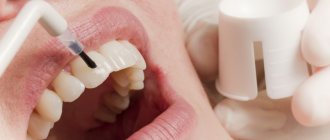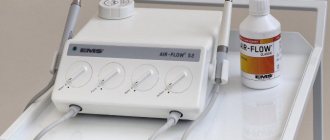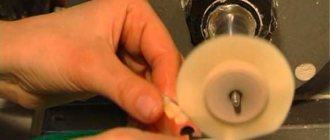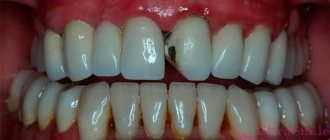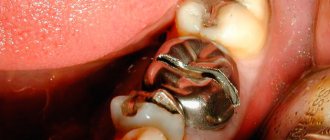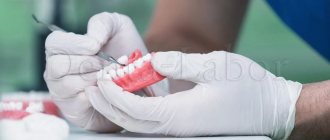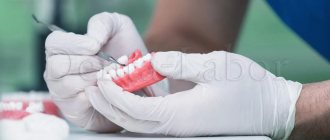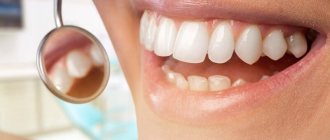5945
Teeth grinding is a procedure aimed at achieving two goals at once: on the one hand, there are fewer bacteria on smooth enamel, the rate of plaque formation is reduced, on the other hand, teeth become lighter.
That is, this manipulation is another step towards a healthy and attractive smile.
Process technique
In dentistry, grinding refers to the leveling of enamel through mechanical action . You should not try to perform a similar procedure at home, because... Without professional skills, it is easy to damage the enamel.
This manipulation is part of a single complex for treating the surface of the teeth: it follows immediately after professional cleaning , thanks to which the oral cavity gets rid of contaminants.
At the same time, the procedure precedes the polishing stage , with which it is closely related.
Professional cleaning and grinding of the teeth place local stress on the enamel. Polishing, on the contrary, thanks to the application of special compounds, acts as a protective manipulation for the surface.
What is polishing
Polishing belongs to the category of professional cleaning. This is a dental procedure that is prescribed after each dental procedure. Polishing has several useful properties:
- Teeth become smooth and white.
- breath disappear .
- Prevents dental diseases.
The polishing procedure ultimately gives not only the external effect of whitening and smoothness, but also disarms the surface of the incisors, providing protection against the development of oral diseases.
In what cases is it necessary
Grinding of teeth followed by polishing is carried out to achieve the following goals :
- The need for post-processing after cleaning from unwanted plaque and tartar: the procedure is an effective method in a preventive complex designed to prevent the occurrence of such problems in the future.
- Achieving the most comfortable state for the patient .
The surface of the dentition, which has undergone professional cleaning, becomes noticeably rough. This is the result of exposure to abrasive particles used in dentistry. To avoid discomfort, roughness must be removed by grinding. - Grinding at the separation level is a necessary part of treatment in orthodontics: it is performed before and after installing braces.
In addition, grinding accompanies the filling procedure to give the desired shape to a tooth that has undergone any physical impact from the dentist.
When installing fillings, cements and pastes that have a plastic consistency are used. However, when hardened, these compositions do not take on a shape that would correspond to the natural anatomical one.
To remove protruding particles, selective grinding is used, which is especially important on the front teeth.
Failure to do this procedure may lead to negative consequences.:
- patient complaints that he feels “something extra” in his mouth;
- Curvature even at the level of one unit can lead to malocclusion.
- irritation of the mucous membrane, because with the increased sensitivity of these tissues, any foreign object, even special dental compounds, can cause damage and contribute to the development of inflammatory processes.
Read how you can strengthen your gums at home in a new publication.
In this material we will tell you what to do if a piece of front tooth enamel breaks off.
Here https://www.vash-dentist.ru/krasota-i-uxod/otbelivanie/opalescence.html we’ll talk about whether the Opalescence system is suitable for home teeth whitening.
This procedure has a fairly short number of contraindications; it is impossible to carry out if you have:
- viral infections (like any other dental procedure, with the exception of extremely urgent ones),
- inflammation of the oral cavity,
- untreated pathologies (caries, bleeding),
- too thin enamel.
In any case, you should first contact your dentist for advice.
Polishing tools
The entire polishing process is carried out using several replaceable attachments on a drill. An abrasive paste is applied to the working surface, after which the enamel is exposed at high speeds.
The following attachments are available:
- in the form of a rubber bowl - for flat surfaces;
- a cone-shaped brush - for treating natural tubercles on distant teeth;
- strips - for hard-to-reach areas, including the interdental area.
Special pastes contain silica, silicate, zircon, xylitol and fluorine. They are distinguished by abrasiveness:
- high degree - eliminates dense stains;
- medium degree - polishing of small deposits;
- low degree - polishing of color irregularities;
- very low level - maximum softness to complete polishing.
Sequence
Grinding of the tooth surface is most often done using classical technology .
The traditional approach involves the use of a drill and special pastes with a granular structure. The dentist has a number of special instruments, as well as ultrasonic attachments and drill tips.
Pastes are used in a certain sequence - from higher to lower grain levels:
- first, a coarse paste is applied, with which the dentist cleans off the largest fragments;
- further – medium-grained;
- at the final stage, a fine-grained composition is used, which removes the smallest particles of abrasive material.
This contributes to the most adequate smoothing of irregularities. This method is relevant for correcting the shape of a tooth.
For the purpose of grinding enamel, other sets of auxiliary materials are also used. For example, fine-grained burs are used, as well as corundum heads.
The dentist also resorts to using a set of special heads, strips and discs during the subsequent stage - polishing. Specialized paste-like compositions are used. At the end of the procedure, fluoride preparations are used.
The process is not inherently complicated: a special composition is applied and the surface is processed using a tool (brush, cap, tip, etc.).
Traditional grinding is gradually being replaced by the technology of using air masses for the same purpose. The equipment is built on the principle of functioning of a mini-sandblasting tool for grinding.
The result of the impact is the removal and removal of tissues that have become a “victim” of the reaction with abrasive particles.
Professionals note that air grinding has a number of advantages over classical grinding:
- It is devoid of all the physical disadvantages of the drill, which cause discomfort for the patient and partly for the dentist himself: temperature, pressure, noise and vibration do not accompany this procedure.
- There is no need to inject large amounts of anesthesia. Local impacts are possible.
- Less risk of damage to tissue and tooth enamel.
- The procedure is faster and requires less effort on the part of the doctor.
Thus, air grinding is a progressive method in dentistry. However, the option of partially exaggerating the positive features of the method for advertising purposes cannot be ruled out.
Already today, opponents of this approach note a number of disadvantages, for example, a significant increase in the sensitivity of the enamel after the procedure, the impossibility of use in deep cavities reaching the level of the pulp.
Also, only composite material is susceptible to the influence of air, while compositions using silver cannot be adjusted in this way.
For another type of tooth enamel grinding – stripping, watch the video:
A few words about grinding
Grinding is the procedure that is performed before polishing. This cleaning is considered more aggressive, since due to mechanical action it causes local stress on the enamel.
The procedure is in many ways similar to polishing; it also uses a device and a paste with grinding particles. There is also a type of air sanding that performs a gentler action. But the difference is that grinding has a greater effect and is indicated for people with pronounced dental problems.
Is it painful to do?
Unfortunately, teeth grinding is a rather unpleasant procedure. Painful sensations cannot be avoided even with the use of modern technologies.
It is necessary to understand that this manipulation involves the use of drugs that will temporarily desensitize the area of the oral cavity that will undergo the intervention. Local anesthesia is usually used .
About ways to care for teeth with braces, our next review.
In the next article, we will discuss whether lemon essential oil can be used to whiten teeth.
At the link https://www.vash-dentist.ru/krasota-i-uxod/narashhivanie/klyikov.html you will find a video of how the canine extension procedure takes place.
This applies to cases where the body of the unit itself is sharpened. At the same time, removing and smoothing out excess particles that appeared when using filling material is not a painful procedure, but rather unpleasant.
It is worth considering: for some time after the procedure, tooth enamel will be more sensitive than usual. The duration of the period depends on the individual characteristics of the organism.
Eating very hot or cold, solid foods may be problematic during this time.
Ideally, you should try to protect the enamel from such influences until the end of this stage.
Is there any harm to enamel?
If the technology is followed properly, there is no need to worry about the condition of the oral cavity in general, and enamel in particular, as a result of this procedure. She is absolutely harmless.
Moreover, periodic visits to the dentist for professional cleaning followed by grinding and polishing are necessary to avoid the formation of tartar and the subsequent development of pathologies.
Thus, teeth grinding provides professional care and is not harmful to the enamel . A pleasant “bonus” for undergoing the procedure will be the acquisition of a more attractive smile appearance.
Contraindications
Despite the large number of positive actions, this procedure has a number of prohibitions. If the doctor detects an alarming symptom in the patient, this becomes the reason for refusing to prescribe the procedure. Main contraindications:
- Bleeding gums.
- Acute periodontitis.
- Deep caries.
- Hypersensitive enamel.
- Inflammation in the oral cavity.
Before cleaning your teeth, you need to treat other oral disorders that may interfere with the procedure.
Aftercare recommendations
The recommendations are mainly due to the fact that teeth become sensitive after the procedure. That is, you should avoid eating foods that seem very hot or cold.
It is also worth giving up too hard foods for a while. All this can be adjusted by trusting your own feelings regarding pain and comfort.
There are also specific tips. Thus, doctors recommend minimizing the consumption of foods that have a “coloring” effect. We are talking not only about certain berries, but also, above all, about tea and coffee.
This measure must be observed for two weeks in order to maintain the pleasant appearance of the cleaned enamel. You can at least switch to green tea at this time. You should also try to minimize smoking.
Price
The teeth grinding procedure is far from the most expensive in dentistry. For one jaw, its price varies around 1000 rubles, which for one unit is usually 100-200 rubles.
However, you need to understand that the impact of this type on one tooth is usually included in the complex of treatment of this unit, most often its filling.
Enamel polishing , on the contrary, is usually highlighted in the price list and is provided as a separate service. However, it would be reasonable to decide on a one-time payment for comprehensive oral hygiene. In this case, you will need to pay a little more than two thousand rubles for one jaw.
Reviews
Patients who have successfully completed the procedure note that the result debunks the myth about subsequent tooth decay. Moreover, they often write that teeth begin to look whiter and more beautiful.
Sometimes they complain of increased sensitivity, as a result of which they cannot live a normal life, for example, drink hot coffee in the morning. But a small percentage of negative reviews, most of which were the result of the dentist’s unprofessionalism, suggests that in general this procedure is useful and safe.
You can share your opinion in the comments to this article.
If you find an error, please select a piece of text and press Ctrl+Enter.
Tags: tooth enamel professional teeth cleaning ultrasonic teeth cleaning teeth cleaning
Did you like the article? stay tuned
Previous article
Biohorizon implants: features of installation and engraftment
Next article
What determines the service life of dental implants?
Write a comment
Ksenia
August 8, 2016 at 6:38 am
I went to the dentist for a grinding procedure. The doctor with whom I had dental treatment advised me to do it; he said that grinding is also used to clean the surface of teeth from complex plaque and stones. And since I drink a lot of coffee, I need this procedure. Yes, I can’t say that the procedure is pleasant, after all, these are medical, albeit hygienic, manipulations, but I really liked the result. The teeth became smoother, shine appeared, plaque and stones were cleared. It is worth considering that the effect is quite individual, many complain that tooth sensitivity appears, I took this point into account and specifically a week before grinding, and a week after, I brushed my teeth with a special paste that reduces tooth sensitivity.
Alexander
August 9, 2016 at 4:27 am
I've seen enough Hollywood films and I also wanted a snow-white smile. Friends said that it was harmful, that they would erase the enamel and then you would suffer for the rest of your life. First I consulted with a specialist, and then I spoke with the person who did the procedure. It turned out to be not harmful, but on the contrary, useful. Now I walk around with a mouth full of dazzling teeth and a smile from ear to ear. Now there's nothing to hide.
Vladimir
October 11, 2016 at 02:08 pm
Since childhood, I have a terrible stomach for dentists, but from smoking and coffee, which I drink 5-10 times a day, my teeth have become not just yellow, but ugly. As a modern person, I immediately went to the Internet for advice and information, and immediately came across the answer to the question I posed. I plucked up courage and went to the dentist. This procedure turned out to be completely safe, and in some places it was even funny to watch the doctor’s actions. In general, I was pleased with the result, and after the instructions of my doctor, I began to take better and more careful care of my oral cavity!
Anastasia
October 24, 2016 at 8:55 am
I did this procedure once, when I discovered a cinnamon coating on my teeth, I thought it was caries. I ran to the doctor, and they told me that it was just tartar and that this problem is common. They offered to do ultrasonic cleaning - I really liked the result, no plaque, firstly, the procedure was painless and also inexpensive.
Denis
November 22, 2016 at 6:24 am
My teeth grinding went well. There was no particular pain, but mostly it was periodically unpleasant to feel the machine buzzing in your mouth and scraping something. The doctor recommended grinding at least once a year. Because I smoke and love coffee very much, and after some time plaque forms on my teeth, especially on the inside. The procedure is not expensive, and after it your teeth sparkle with whiteness.
Svetlana
October 31, 2022 at 10:23 am
Every year I go through the polishing procedure. As a result, there is no plaque and the teeth are healthier; there have been no caries for three years now.
Sanding and polishing the restored surface
The stage of final surface treatment of the restoration is given great importance because at this stage the doctor can either significantly extend the service life of the restoration or shorten it. Not to mention how much the aesthetic perception of the restoration as a whole increases after a competently performed grinding and polishing stage.
Leading manufacturers of light-curing materials have developed entire programs for the final processing of fillings, but, strictly speaking, the principle remains the same: first, excess material is removed, forming an anatomical shape. This step can be carried out using diamond burs, which have a red marking ring on the shank. Particular care must be taken when working at the interface between the restoration and the enamel, so as not to damage healthy enamel.
It is necessary to work only with water cooling, periodically using carbon paper for control. Then we move on to the next stage and special finishing diamond burs of various shapes, the shank of which is marked with a yellow marking ring.
These burs can be used to create characteristic anatomical features of the structure of the tooth being restored. This stage, which is sometimes called “contouring the restoration,” can be supplemented by the use of well-proven sets of polishing discs with different abrasive grains - Sof-Lex (3M) or silicone polishing heads (KENDA, VIVADENT).
Contact surfaces are polished with special abrasive strips, which have varying degrees of grain size. To facilitate insertion of the strip into the interdental space, there is an area in the middle of the strip that is free from abrasive. They must be used with caution only in the area of the tooth neck and closer to the cutting edge, in every possible way protecting the gingival papilla from injury and trying to preserve the contact point. The restoration should not have any overhanging edges, which can be determined using a probe.
If during the first two stages a hidden pore is opened, then it is necessary to lightly treat its surface with a diamond bur of the appropriate size, condition it, wash it, dry it, apply adhesive, fill it with a composite material and polymerize it.
The third stage, polishing, is carried out using rubber cups and polishing pastes, which may also contain fluorine compounds, in contrast to pastes used for mechanical cleaning of the tooth surface before determining the color of the material.
Polishing is carried out at low speeds. The effectiveness and correctness of polishing is determined by the presence of a mirror shine of the dried surface of the restoration, comparable to the shine of healthy tooth enamel.
To achieve this polishing effect, a system for finishing composite restorations has been developed by Kegg. This system is based on the use of special 12- and 30-notch carbide burs, polishing heads and diamond paste with a particle size of 0.2 microns in a certain sequence. The advantage of carbide burs over diamond burs is as follows:
Carbide burs, unlike diamond burs, practically do not damage the enamel.
Grinding with carbide burs allows you to achieve a perfectly smooth surface of the composite restoration.
Carbide burs have a tip that does not injure the marginal gum.
The shape of the burs is designed taking into account the anatomy of the teeth. When working with carbide burs, it is necessary to use a water jet, which will prevent heating of the composite surface and at the same time help clean the bur. In case of extreme necessity, dry processing of the composite is also possible, which is carried out with very light, careful touches (without the slightest pressure) in order to avoid overheating of the composite material, as a result of which the “white line” phenomenon can be obtained at the enamel-composite interface.
To significantly extend the life of carbide burs, only hard nylon brushes should be used to pre-clean them; then the burs are cleaned with ultrasound, after placing them in a special block or stand to prevent the burs from coming into contact with each other or any other hard surfaces, which will lead to damage.
The next stage of restoration - the so-called finishing (or final) illumination of all surfaces of the restoration with a polymerizer after its final polishing - is debatable. There are no special studies on this issue confirming the validity of this procedure, but there is a concept according to which the final stage of polymerization is carried out to ensure complete curing of the composites on the surface of the restoration. The fact is that grinding to give an anatomical shape and subsequent polishing removes several hundred microns, and sometimes millimeters of material, so another polymerization step can fully polymerize the new top layer of material.
Treatment of the restoration surface with sealants
The final stage of restoration consists of coating the surface of the restoration with special SEALANTS such as OPTIGUARD (KERR) or Fortify (Bisco). The use of these materials makes it possible to “seal” surface microcracks that may appear after grinding and polishing the filling. The use of SILANT gives confidence that the restoration will be less susceptible to staining. Karl Leinfelder conducted studies that showed a significant reduction in abrasion of the filling surface over several years after treatment of the Fortify restoration.
Success of restoration
The main condition for successful restoration is that the dentist has a positive motivation to carry out this technique in one way or another. It is the doctor’s conscious, formed conviction of the need for restoration to solve the patient’s problems, not only in the oral cavity, that will have a decisive role in the future fate of the restoration and will increase the effectiveness of treatment of lesions of hard dental tissues.
The technique of aesthetic and functional restoration allows one to solve numerous problems that the patient has.
These problems can be divided into the following groups:
1. Psycho-emotional rehabilitation. Artistic restoration of the tooth, taking into account individual and age-related characteristics, will allow the patient to feel comfortable in society and solve psychological problems, the solution of which was impossible due to interrupted communication connections.
2. Only high-quality restoration, reproducing the smallest anatomical features of the lost hard tissues of the tooth, will restore the damaged occlusal plane and contribute to either increasing the effectiveness of treatment or preventing TMJ diseases, especially its pathology such as pain dysfunction syndrome. Naturally, the treatment of such a pathology should be comprehensive, but the effect of proper restoration of the relationship of the jaws should not be diminished.
3. Prevention and treatment of inflammatory periodontal diseases.
Equally important in the treatment and prevention of inflammatory periodontal diseases is the correct restoration of contact points and the anatomical shape of the chewing surface, taking into account the loss of bone tissue in moderate and severe periodontitis. The combination of the use of a modern restoration system with a convenient and high-quality matrix system will eliminate overload of the periodontium and trauma to the papillary and marginal gums, eliminating retention points that complicate oral hygiene.
4. Prevention of recurrent caries.
Modern restoration systems, especially when used in the layer-by-layer technique, make it possible to carry out restorations with low enamel resistance to caries. Low resistance of enamel to caries is quite common and depends on many reasons. The possibility of using materials that increase the resistance of enamel by saturating it with fluoride ions expands the indications for restoration with their use, even with poor oral hygiene.
5. The problem of intolerance to restoration materials.
All modern materials on the Russian dental market are certified and do not have any toxic effect on the organs of the oral cavity, including the oral mucosa. In this case, we are talking about materials that have undergone photopolymerization and therefore do not contain free radicals.
Literature
1. Borovsky E. V., Popova I. I.
Intracanal pins in preparing teeth for restoration of the coronal part // Clinical dentistry. 2000, No. 2. P.32.
2. Borovsky E.V., Ivanov V.S., Maksimovsky Yu.M., Maksimovskaya L.N.
3. Therapeutic dentistry. M.: Medicine, 1998.
4. Makeeva I.M.
Restoration of teeth using light-curing composite materials. M.: OJSC "Dentistry", 1997.
5. Chilikin V.N.
Composite materials and compomer from KERR in the aesthetic restoration program // Bulletin of Dentistry. 1999, No. 3 (70) P.15.
6. Guide to prosthetic dentistry. Ed. V.N. Kopeikina. M.: Medicine, 1993.
7. Chilikin V.N.
Making veneers using the direct method in a therapeutic dentistry clinic // Clinical Dentistry, 1999, No. 3. P.8.
8. Radlinsky SV.
Adhesive technique for artificial dental crowns, or pinned teeth without pins // Dent Art. 1997, No. 1. P.23.
9. Radlinsky SV.
Control of transparency of restoration structures // Dent Art. 1997, No. 4. P.30.



